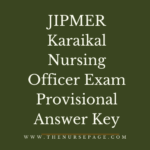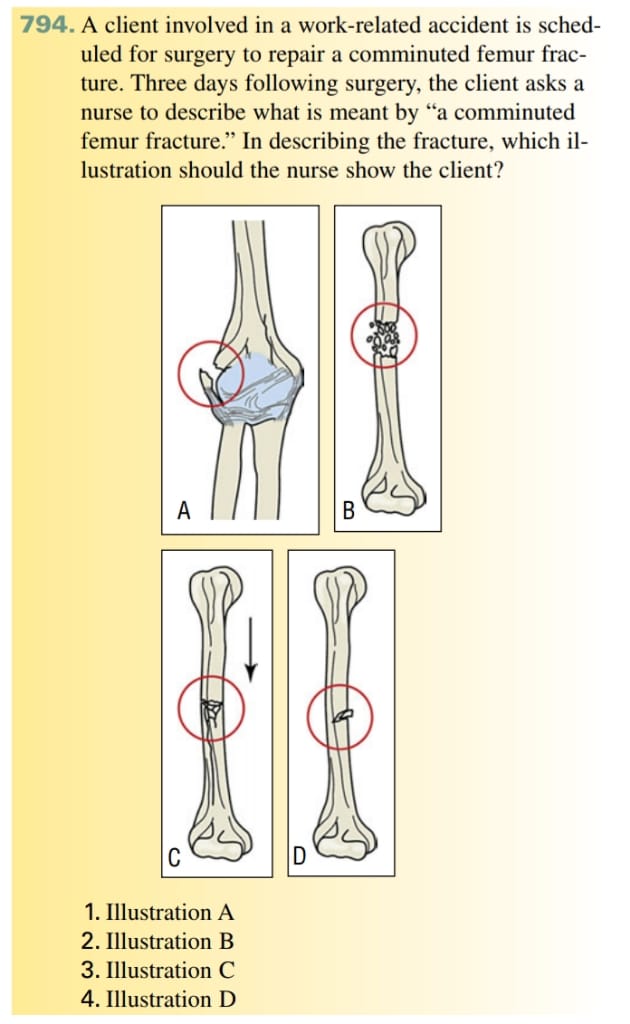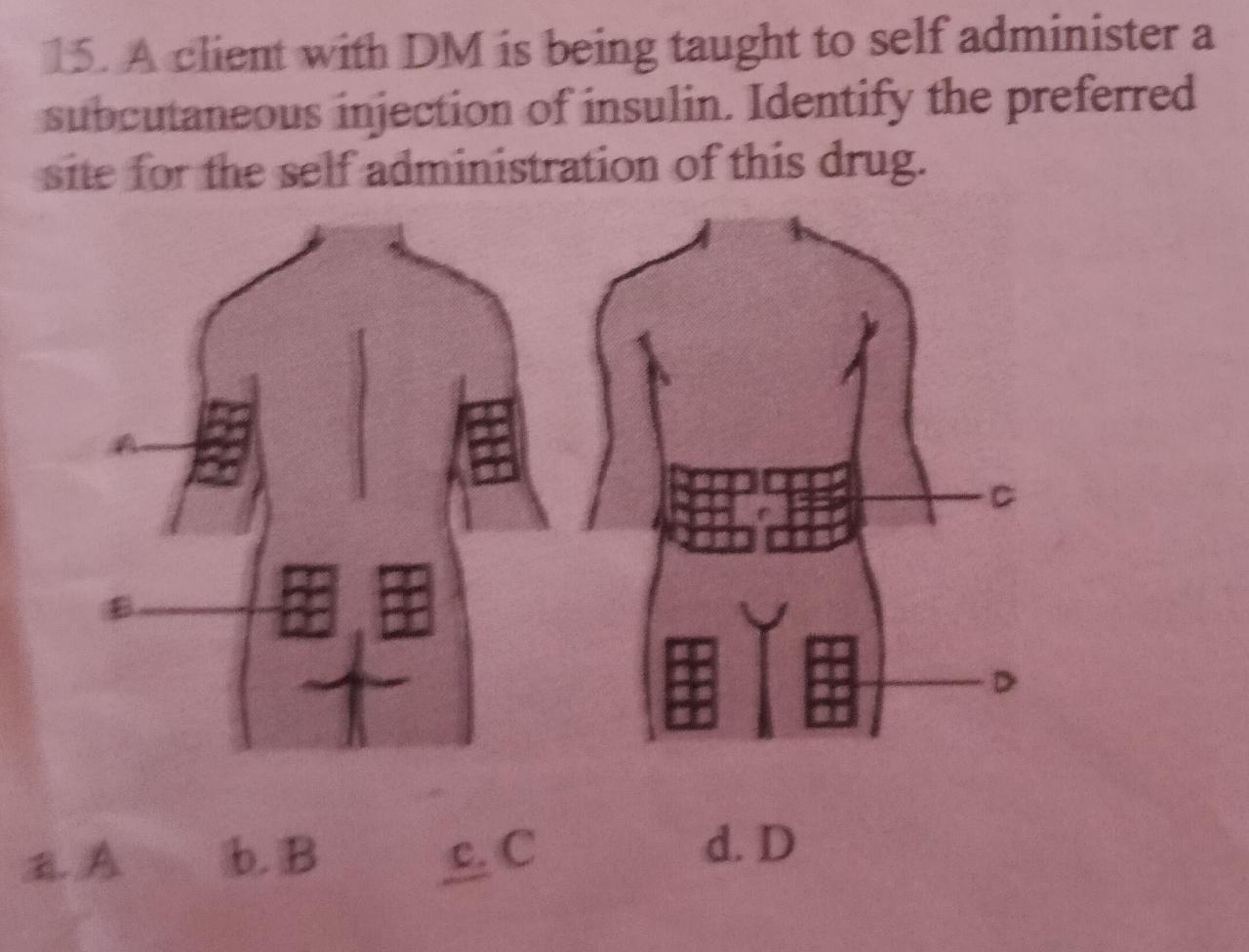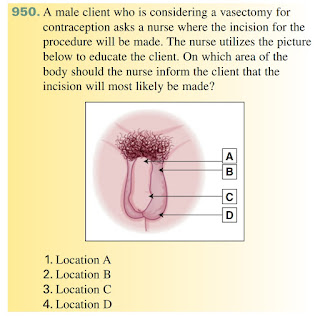
JIPMER Karaikal Nursing Officer Exam Conducted On 07/03/2020 – Provisional Answer Key
1. When analyzing the serum laboratory report for a client diagnosed with lung cancer that has metastasized to the pelvic bone, which finding should a nurse anticipate?
1. Elevated calcium
2. Decreased hemoglobin
3. Elevated creatinine (Scr)
4. Elevated creatine kinase (CK)
Malignant tumors cause hypercalcemia through a variety of mechanisms, one being an increased release of calcium from the bones.
3. Which priority nursing diagnosis should a nurse document in the plan of care for a client following a
C5–C6 anterior cervical discectomy?
1. Potential ineffective breathing pattern
2. Potentially impaired tissue perfusion
3. Risk for infection
4. Impaired skin integrity
4. A homeless client, visiting a health clinic, is noted to have a smooth and reddened tongue and ulcers at the corners of the mouth. The client was tentatively diagnosed with a hematological disorder, and laboratory tests were prescribed. Based on this information, a nurse should expect the client’s laboratory results to reveal:
1. low hemoglobin.
2. elevated red blood cells (RBCs).
3. prolonged prothrombin time (PT).
4. low white blood cells (WBCs).
5. One month after discharge, a client who had a left total hip replacement calls a clinic reporting acute constant pain in the left groin and hip area and feeling like the left leg is shorter than the right. A nurse advises the client to come to the clinic immediately suspecting:
1. Wound infection.
2. Deep vein thrombosis (DVT).
3. Dislocation of the prosthesis.
4. Aseptic loosening of the prosthesis.
6. Which assessment should a nurse perform to obtain the most accurate determination of fluid balance for a child with hydronephrosis?
1. Measuring the client’s intake and output
2. Weighing the client
3. Assessing for the presence of edema
4. Evaluating serum electrolyte results
Weight is the most accurate. Intake and output provide data, but there is additional fluid lost through the skin, lungs, and the gastrointestinal tract that cannot be measured. Edema is an indication of fluid retention but is not accurate.
7. The family of a client who is scheduled for emergency surgery following an accident asks if they can donate blood for the client. The client’s blood type is B negative. A nurse informs the family that packed red blood cells (PRBCs) could likely be used by family members whose blood type is:
1. type A positive.
2. type B positive.
3. type B negative.
4. type O positive.
5. type O negative.
Q. A nurse teaches a co-worker that the treatment for hemophilia will likely include periodic self-administration of:
1. Platelets.
2. Whole blood.
3. Factor concentrates.
4. Fresh frozen plasma.
A person with hemophilia A is deficient in factor VIII, hemophilia B, factor IX Recombinant form of the factors are available for the client to self administer intravenously at home
9. A nurse has reviewed the upper arm blood pressure (BP) results for multiple children between the ages of 3 and 5 years. Which BP reading should the nurse evaluate as being an abnormal BP for this age group?
1. 96/42 mm Hg
2. 101/57 mm Hg
3. 112/66 mm Hg
4. 115/68 mm Hg
10. A nurse is performing hourly neurological assessment checks on a client who is admitted with changes in mental status. The nurse understands that frequent assessments are used to determine if a client is developing increased intracranial pressure (ICP). Which option correctly describes the outcome?
a) displacement of brain tissue
b) increased in cerebral circulation and perfusion
c) increase in serum pH
d) improved brain tissue oxygenation
11. Following an industrial accident in which a client
sustained severe craniocerebral trauma, the client
develops the complication of diabetes insipidus (DI).
A nurse suspects this complication is occurring when
observing which symptom?
1. Hyperglycemia
2. Large amounts of urinary output
3. Elevated urine specific gravity
4. Decrease in level of consciousness
DI is associated with decreased production or secretion of antidiuretic hormone (ADH). This causes increased urine output and increased plasma osmolality.
12. A nurse is analyzing serum laboratory results for a 73-year-old female client scheduled for surgery in 2 hours. The nurse concludes that which result would warrant the most immediate notification of the physician?
1. Hemoglobin 10 g/dL
2. Creatinine 1.0 mg/dL
3. Potassium 4.5 mEq/dL
4. Prothrombin time 22 seconds
Normal Prothrombin time is 12 – 14 seconds, so PT is 22 indicate there is a problem in blood coagulation which may lead to increased bleeding during surgery.
13. Nurse is caring for a paediatric client who has congestive heart failure (CHF). The client is receiving digoxin therapy. Which laboratory test result is most important to evaluate when preparing to administer digoxin?
1. Serum potassium levels
2. Serum magnesium levels
3. Serum sodium levels
4. Serum chloride levels
14. A client is scheduled for an outpatient electroencephalogram (EEG). A nurse instructs the client to prepare for the test by:
1. removing all hairpins.
2. avoiding eating or drinking at least 6 hours prior to
the test.
3. being prepared to have some of the scalp shaved.
4. having blood drawn for glucose level 2 hour before EEG
In an EEG, electrodes are placed on the scalp over multiple areas of the brain to detect and record patterns of electrical activity. Preparation includes clean hair without any objects in the hair to prevent inaccurate test results.
15. A client is admitted to an intensive care unit because of a leaky cerebral aneurysm. A family member asks a nurse why the client is awakened and questioned about his orientation so frequently when he needs to rest. The nurse answers the family member based on the knowledge that the earliest sign of ICP is:
A. pupillary changes
B. drop in BP
C. altered sensation
D. changes in LOC
16) A client is admitted to a hospital with a diagnosis of acute pyelonephritis. Which symptom occurs most frequently and should be monitored by the nurse?
1. Low-grade fever
2. Bradycardia
3. Flank pain on the affected side
4. Rebound tenderness in left lower quadrant
17) A nurse is assessing a blood pressure of an adult client with a manual sphygmomanometer. The nurse places the bell diaphragm of the stethoscope over the brachial artery and pumps the cuff up to 180 mm Hg. The valve is released to allow a drop of 2 mm Hg per second. At 162 mm Hg the nurse hears the first tapping sound. The sound becomes muffled at 148 mm Hg. The sound changes to a soft thumping at the 138 mm Hg. The sound fades to a muffled blowing sound at 128 mm Hg and is last heard at 94 mm Hg. There is silence at 92 mm Hg. The nurse should document the blood pressure as:
1. 138/92 mm Hg.
2. 148/94 mm Hg.
3. 162/92 mm Hg.
4. 162/94 mm Hg
18) A client with a diagnosis of Guillain-Barré syndrome is scheduled to receive plasmapheresis treatments. A nurse explains to the client’s spouse that the purpose of plasmapheresis is to:
1. remove excess fluid from the bloodstream.
2. restore protein levels in the blood.
3. remove circulating antibodies in the blood
19). A nurse is caring for a client who received conscious sedation during a surgical procedure. Which assessment of this client is most important for a nurse to make postoperatively?
1. Lung sounds
2. Amount of urine output
3. Ability to swallow liquids
4. Rate and depth of breathing
Moderate sedation (conscious sedation) is used routinely for procedures that do not require complete anesthesia, but rather a depressed level of consciousness.
20) A 39-year-old client presents in active labor. The client is breathing rapidly and having difficulty coping with the contractions. Based on this assessment, what would a nurse predict should occur if interventions are not initiated immediately?
1. Respiratory acidosis
2. Respiratory alkalosis
3. Metabolic alkalosis
4. Metabolic acidosis
21) A nurse evaluates that the drainage from a client’s nasogastric (NG) tube, inserted for gastric decompression during emergency surgery, would be normal if it:
1. returns brown-liquid in color.
2. returns greenish-yellow in color.
3. has an alkalotic hydrogen level (pH).
4. measures less than 25 mL in volume.
22) A client who has had a stroke stares at a nurse but does not attempt to verbally respond to the nurse’s questions. The client follows instructions without any problems. The nurse understands that the client is displaying symptoms consistent with:
1. receptive aphasia.
2. global aphasia.
3. expressive aphasia
4. both receptive and expressive aphasia
23) A nurse notifies a physician after assessing a client 5 days after an exploratory laparotomy and noting a distended abdomen, abdominal pain, absence of flatus, and absent bowel sounds. Which typical complication of abdominal surgery should the nurse conclude may be occurring?
1. Paralytic ileus
2. Peritonitis
3. Wound dehiscence
24) Various children are being seen in the clinic for well-baby checks. By what age should a nurse expect a child to begin to use simple words to communicate needs?
1. Age 10–12 months
2. Age 1–2 years
3. Age 6–9 months
4. Age 2–3 years
25) Which result should a nurse expect if a 4-year-old child’s visual acuity test is normal for the child’s developmental age?
1. 10/10
2. 20/20
3. 20/40
4. 40/40
26) Which assessment finding should a nurse expect following administration of phenylephrine (Neosynephrine®) eye drops to perform an ophthalmoscopic eye examination?
1. Tremor
2. Hypotension
3. Pupil miosis
4. Pupil mydriasis
27) A client presents with meningioma and symptoms of increased intracranial pressure. Which manifestations should a nurse least expect to find an assessment of this client?
1. Headache
2. Vomiting
3. Pyrexia
4. Papilledema
28) An experienced nurse explains to a new nurse that the definitive diagnosis of peptic ulcer disease (PUD) involves:
1. a urea breath test.
2. upper gastrointestinal endoscopy with biopsy.
3. barium contrast studies.
4. the string test.
29) A clinic nurse is administering monovalent HepB (hepatitis B vaccine) intramuscularly to a newborn prior to hospital discharge. Which site is best for the nurse to plan to administer the injection?
1. Deltoid
2. Ventrogluteal
3. Dorsogluteal
4. Vastus lateralis
30) After a car/pedestrian accident, a pedestrian client is brought to the emergency room. The client is alert and oriented but complains of dyspnea. Oxygen saturation (SpO2) levels vary from 88% to 90%. Oxygen is applied at 2 liters per nasal cannula with no improvement in SpO2. Oxygen per mask is initiated at 40% with little improvement. Radiograph films reveal no obvious injury or fractures. Suddenly the client loses consciousness, has a respiratory arrest, and subsequently dies. During the respiratory arrest resuscitation, it is determined that a nurse failed to open the valve to the oxygen tank and the client had not been receiving oxygen. What is the key ethical principle involved in this situation?
1. Nonmaleficence
2. Fidelity
3. Beneficence
4. Justice
31. Which lobe is responsible for feeling and touch?
1. Frontal
2. Parietal
3. Occipital
4. Temporal

The correct answer is Option 1 Neck and cervical lymph nodes

The correct answer is Location D(From the foot)

The correct answer is Option B
A comminuted fracture is a break or splinter of the bone into more than two fragments

The correct answer is Option C (Abdomen around the umbilicus)

The correct answer is Option B
37. Which medication should a nurse apply topically in second- and third-
degree burns to treat bacterial and yeast infections?
1. Bismuth subsalicylate (Kaopectate®)
2. Gold sodium thiomalate (Aurolate®)
3. Silver sulfadiazine (Silvadene®)
4. Arsenic trioxide (Trisenox®)
The correct answer is Silver Sulfadiazine
38. Famotidine work as? (Mission High Nursing Classes Online test series)
a. Histamine2 receptor blocking agent
b. Histamine2 inducing agent
c. Proton pump inhibitor
d. Neutralize the HCL
The correct answer is Histamine 2 receptor blocking agent
Famotidine is the histamine or H2 receptor blocking agent that work as
decrease secretion of HCL in the stomach.
39. which part of brain have least survival chance if injury occurred in?
A mid brain
B hypothalamus
C medulla
D pons
The correct answer is medulla
Because vital organ(respiratory & cardiac) regulatory centre located at
hypothalamus.
40. most common sign in biliary colic?
A severe abdominal pain
B abdominal distention
C fever
D nausea vomiting
The correct answer is severe abdominal pain
41. Tapid bath temp?
a. 90 – 95 degree F
b. 95 – 100 degree F
c. 100 – 105 degree F
d. 105 – 110 degree F
Answer- A
42. Nobel peace prize winner 2019?
– Abiy Ahmed Ali
43. Complication associated with uterine prolapse?
A cervical cancer
B ulceration
C precipitated labour
D uterine rupture
The correct answer is ulceration
44. Irregular body temperature occurs in which portion of brain involved in
accident?
A hypothalamus
B thalamus
C medulla
D mid brain
The correct answer is hypothalamus
45. Confirmatory test for down syndrome of a 16 week fetus??
A chorionic villi sample
B amniocentesis
C USG
D blood culture
The correct answer is amniocentesis
Chorionic Villi Sampling is done at 10 to 12 week of pregnancy
Amniocentesis is done at 16 week of pregnancy
46. Fertility test done at?
A before ovulation
B 1-2 hour after ovulation
C in menstruation cyle
D before menstruation cycle begin
The correct answer is 1 – 2 hour after ovulation
47. When bathing a patient’s extremities, the nurse should use long, firm
strokes from the distal to the proximal areas. This technique:
a. Provides an opportunity for skin assessment
b. Avoids undue strain on the nurse
c. Increases venous blood return
d. Causes vasoconstriction and increases circulation
The correct answer is increases venous blood return
48. Most common cause of abortion in 1st trimester of pregnancy?
a. congenital anomalies
b. fetal anomalies
c. embryonic defects
d. maternal cause
The correct answer is embryonic defects
49. Laboratory Tumor marker for liver cancer?
a. AFB
b. CA- 125
c. HCG
d. PSA
The correct answer is AFB
For liver cancer – AFB
CA-125 – GI tract and Ovary or GO
HCG – for testes cancer
PSA – for prostate cancer
50. Where is located Gateway of India?
a. Mumbai
b. New Delhi
c. Kolkata
d. Jaipur
The correct answer is Mumbai
51. 57. A client is receiving mannitol, the nurse assess the client for evidence
of which clinical problem, for which the client at risk?
a. Dehydration
b. Somnolence
c. Tinnitus
d. Fatigue
The correct answer is dehydration
Most of the questions are coming from quizlet website and course hero website. So please go through the website for further information
JIPMER Karaikal pdf answer key
Image-Based Questions For AIIMS Exams
Positive and Negative Symptoms of Schizophrenia
Please Subscribe Our YouTube channel – The Nurse
Like our Facebook Page: The Nurse
Please Subscribe to get all our posts in your mail inbox